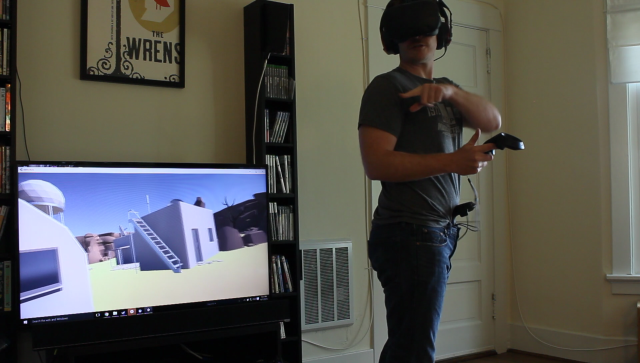
As much as we love the latest virtual reality rigs for Windows PCs, playing a game doesn't always feel realistic. The Oculus Rift and HTC Vive track head motion incredibly well, and the Vive adds solid hand tracking, but the rigs are bad at other things you'll want to do once you feel transported—particularly any movement beyond the size of your office or living room.
So far, the solutions to long-distance VR movement have left us a bit wanting. Pressing a control stick to virtually move while sitting still in real life usually results in instant nausea, so that's out. "Teleportation" systems let users point at a spot in the distance and automatically appear there, which works fine but feels a little limited, while giant walk-simulation treadmills are too expensive, hot, and bulky for realistic home use. The latest solution, introduced by a game maker out of Boston, is the most realistic-feeling yet—so long as you're fine with sticking a plastic controller down your pants.
Ryan Sullivan began working on his "RIPmotion" system (as in, run-in-place) in January after a failed attempt at making a sort of "hoverboard" control system. His first prototypes attempted to connect a user's head orientation to movement, but none of those quite worked. His eureka moment came last week, when he stopped trying to connect user orientation to where the head or hands pointed.
"Your hips always point the way you are running, because that's how legs work," Sullivan wrote in an update from Wednesday. He bemoaned the lack of ways to securely or neatly track a person's hip position in VR systems thus far, but until such systems are developed, he came up with a neat (if slightly uncomfortable and certainly awkward looking) trick: put an HTC Vive controller down your pants. The Vive's tracking stations are so effective that they can track a controller's donut-shaped sensor even when it's tucked into a belt, and securing it front-and-center on the waist ensures that hip orientation is accurately tracked.
Invite friends to shove a wand down their pants
Sullivan followed that update a few days later with a prototype download on Sunday. After a few minutes of testing, I immediately decided to film myself shoving a controller down my pants and looking like an idiot. Why? Because it works.
The RIPmotion prototype dumps players into a flat, sparse desert scene that is dotted with tents, cacti, and other random objects. You can walk around your HTC Vive's pre-set space and use your controllers to shoot little white dots, but the good stuff starts once you tuck one controller into a belt loop or your pants. However you secure it, just make sure the donut end is pointing forward, as this determines hip position.
You can arbitrarily pick either wand for pants duty, because you activate the run-in-place interaction by holding down the side-grip button on the wand you keep in your hand. Once you hold this down, you can run in place, and your speed determines how fast you move in the direction your hips are facing. The sensing results aren't perfect—particularly if you run in place with quick, tiny steps—but it can tell the difference between a plodding trot and a decent gallop.
The prototype's simple dot-shooting mechanic is possibly its most important detail, because it let me test and confirm how effectively and comfortably I could run and gun. I could look and aim in whatever direction I wanted while running, and my legs' orientation still dictated which way I actually moved, which absolutely sold the prototype's realistic, no-nausea feeling. I did find myself occasionally drifting toward a real-life wall while running, but the Vive's "chaperone" safety grid did a good job of nudging me back to safer movement spots, and I liked being able to stop my run-in-place motion to duck, dodge, or otherwise naturally move, as I might want to do in something like a Call of Duty shooting game."I don't think this is a particularly useful mechanic as-is, but I am trying to be forward thinking as far as having additionally tracked points in the future," Sullivan warns in his prototype's description. "Ideally, there would be two tracking points around the waist in addition to the tracked controllers." I agree—this is a very interesting proof-of-concept in the short term, but I don't own anything that I would trust to securely hold a controller around my waist for very long, and I have little interest in having my boxers or briefs play into everyday VR use.
That being said, any VR game developer should rush to try this demo out and imagine the possibilities of the industry's post-pants future.
reader comments
88